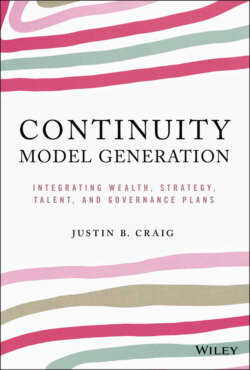Читать книгу Continuity Model Generation - Justin B. Craig - Страница 9
Acknowledgments and Appreciation
ОглавлениеFirst, I respectfully acknowledge the family of business-owning families worldwide who have taught and inspired me, and countless contemporaries, through their commitment to establishing models that ensure future generations continue to make significant social and economic impacts. Thanks for allowing me to stalk you!
Second, to those whose thinking, testing, pivoting, and retesting have contributed to my ability to interpret and share the 21 frameworks and bring them together as the Continuity Canvas. I am fortunate to have worked closely with several of the family enterprise field's pioneers over the past two decades. Notable amongst these are my two main mentors (and mates), Professors Emeriti Ken Moores and John Ward. These two gentle men have more in common than they know…And I know that because I have been fortunate enough to spend countless hours learning at their feet. Ken and John, I hope this book brings your thinking to a new generation of family enterprise zealots, and I'll do my best to ensure it does. Your fingerprints are all over these pages.
I also need to tip my hat, in no particular order, to the colleagues and practitioners who have helped craft my thinking and enflame my passion for family enterprise. To the Dennis family for sharing your journey with me for the past two decades; thank you for the Four Rs as well as the Church and State framework. To the Urrea family, who have recently brought additional texture and sophistication to the Church and State approach to governance. To the Millers for their amazing work with the Four Cs framework… truly groundbreaking. To Professor Ivan Lansberg, whose eloquent portrayal of the Four Tests is timeless. To the pioneering Professor John Davis and late Renato Taiguiri, who gifted us such a sound foundation through the Three Circles paradigmatic framework. To my friend Professor Jose Liberti, who enlightened me on the four ways to capture value. To Jim Davis and his colleagues for introducing me and others to stewardship as a theory. To Jim Ethier for helping me understand what Governance Planning really means. And to Drew Everett, who helped me appreciate the meaning of Successors' Talent development. To the Lee family, for allowing me to understand the true meaning of sibling partnership. And to the many families who helped me understand the true meaning of long-term orientation and stewardship.
A separate acknowledgement to friends who have helped me more than they know. To Dr. Dennis Jaffe for his guidance along my trip to now. Dennis was instrumental in getting me started and keeping me going. It was he who provided the final push and the invaluable recommendation to Wiley. And to Caroline Coleman Bailey and her network at the innovative Premier Growth organization. And last but far from least, to Professors Eric Clinton and Catherine Faherty as well as their Irish family business community at Dublin City University. Much of what you will read in the pages that follow was tested for its final ‘proof of concept' with Eric's, Catherine's, and Caroline's learning communities.
To my friends in the professional services community, thank you for helping me to appreciate your important role more fully, and for helping me discover more than just the many moving parts of estate, wealth, and asset planning. In particular, I thank Bruce Hatcher from BDO Australia and Jonathan Flack and Jay Mattie from PwC US. Their passion for genuine understanding has motivated many advisors and subsequently helped countless business-owning families.
I also owe a ridiculously huge debt of gratitude to several people I have never actually met, but whose work I have long admired, “borrowed from,” and paraphrased in these pages. Specifically, to Dr. Ichak Adizes, whose understanding of life cycle is without peer; to Professor Emeritus Robert Kaplan and David Norton for sharing their Balanced Scorecard with me and the world; to Professor Sara Sarasvathy, whose work introducing effectual reasoning has made the complex simpler for so many of us; and to the global community of trust researchers whose work in understanding trust (within, between, and among teams of decision-making teams in family enterprises) underpins everything.
And finally, to my many colleagues at the institutions I have had the privilege to serve. To those who were with me at Oregon State University, Northeastern University in Boston, the Kellogg School of Management at Northwestern University, Dublin City University, and at my alma mater, Bond University. And to other colleagues including Professors Tom Lumpkin, Clay Dibrell, Don Neubaum, and Scott Newbert, who have pushed and challenged me along my anything-but-typical academic journey. And to Catharina Jecklin and Anke Steinmeyer, two doctoral students at Bond University, who represent an exciting new generation of thinkers.
You are all responsible for the Continuity Model Generation. Indeed, these pages harness my intellectual restlessness, which you all have tolerated and nurtured, and for that I am deeply grateful.
Justin
